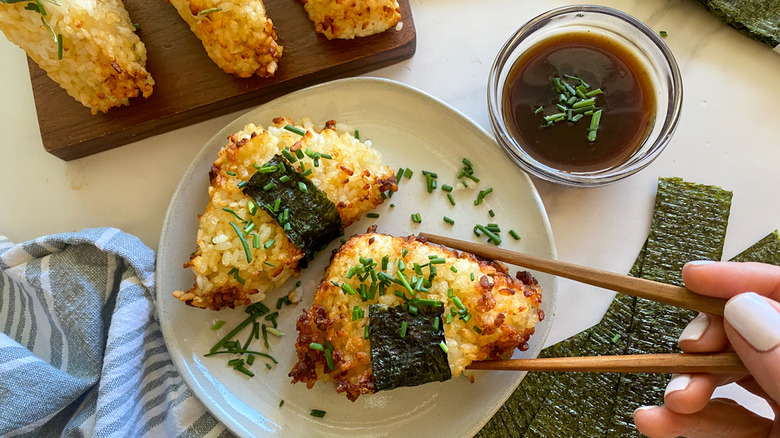Use Miso Paste In Your Homemade Onigiri For An Umami Eruption
Strolling through the streets of Japan, you'll easily find onigiri (also known as Japanese rice balls) in convenience stores, bento boxes, and even restaurants. Small but mighty, this ubiquitous food is a top-notch choice for all those quick snacks or easy lunches that need to fill you up. Its main ingredient is rice, but the filling inside can be freely adjusted, leaving ample room for tailoring to personal preferences. For those who adore deep, complex flavors, perhaps recipe developer Miriam Hahn's approach to yaki onigiri might be worth a try — a miso paste infusion with a gorgeous burst of umami goodness.
With just how popular miso has gotten over the last few years, perhaps it needs no introduction. This fermented soybean paste is a key flavoring in many Japanese dishes, anything from soups, ramen, and stir-fries to grilled seafood. When incorporated into onigiri, its savory, umami eruption becomes the flavor catalyst that ties the rice and the filling together. In place of the usual one-dimensional blandness are sweet, salty, savory, and tangy nuances unfolding seamlessly into the meat and veggies' natural taste. Biting into the onigiri, you'll fall in love with the way the layers of flavors unravel one by one, and then delectably come together.
How to add miso to your homemade onigiri
Miso paste comes in different varieties, often distinguished by color. Generally speaking, the darker the color, the deeper the flavor. The three most common ones are red miso (aka), white miso (shiro), and yellow miso (shinshu). For onigiri, white miso is a preferred choice because of its light and sweet taste. If you like a bit more intensity, however, red miso is the one to go for.
The easiest, most foolproof way to add miso paste to your onigiri is by combining it with other condiments such as soy sauce, mirin, sesame oil, and some spices to make a sauce. Want to add a bit more sweetness to those umami notes? No problem, just use honey and butter instead. This can then be mixed with the rice or the filling for a thorough flavor infusion. Another way to use this miso sauce is by brushing it onto the edges and surfaces of the onigiri before quickly searing or grilling it. This will give your onigiri a crispy, slightly caramelized exterior that perfectly contrasts with the tender inside.
Accompanying the miso sauce is a myriad of food that can add even more intrigue to the onigiri. With the paste readily available, spend a few extra minutes charring it with aromatics like onions, scallions, and garlic for a delectable topping. Even simpler, a sprinkle of toasted sesame seeds or furikake (a Japanese spice mix) is also just as marvelous.

